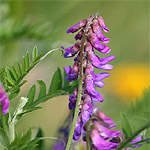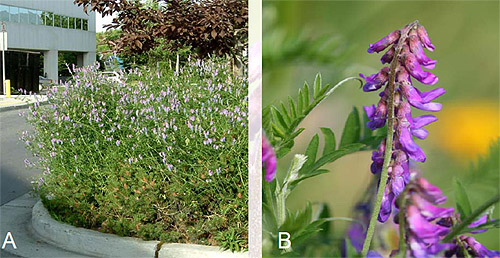Bird Vetch
 Vicia Cracca
Vicia Cracca
Common Names: Tufted Vetch, Cow Vetch
Bird Vetch crowds out native vegetation and can aggressively take over areas of prairie habitat!
Â
History
Introduced from Europe and Asia accidentally as a seed contaminant or purposely for forage and cover crops as it is very tasty to livestock.
Physical Description
General: A climbing or trailing, weak-stemmed perennial herb, 50-125 cm (20-50") long.
Leaves: Pinnately-divided into 8-24 pairs of linear - oblong leaflets, leaf tips with tendrils.
Flowers and fruits: Flower heads are one-sided and hold 20-50 purple to blue 1.5 cm (1/2") long flowers. Bird Vetch blooms from June to August. Fruit is a brownish-black seed pod.

[A] Bird Vetch growing on top of an ornamental pine in a parking lot. J.Nielsen, University of Alaska Fairbanks, Bugwood.org [B] Close up of flowers. K. Peters
Threat
Bird Vetch has escaped from cultivation and is considered invasive in some areas where it can crowd out native plant species. Bird Vetch aggressively climbs fencing, trees, bushes and other vegetation, monopolizing sunlight, space and moisture.
Distribution
Bird Vetch is in Manitoba. It is found throughout Canada in meadows, pastures, row crops, gardens, roadsides, and disturbed sites.
Prevention
Persistent low trimming in early spring can starve the roots and prevent flowers and seeds from developing. Hand removal or herbicide can also be effective control methods. Repeated treatments may be necessary.
Resources
Â
Back to Terrestrial Invasive Species List
© Copyright 2004-2025 - CMS Made Simple
This site is powered by CMS Made Simple version 1.4.1


